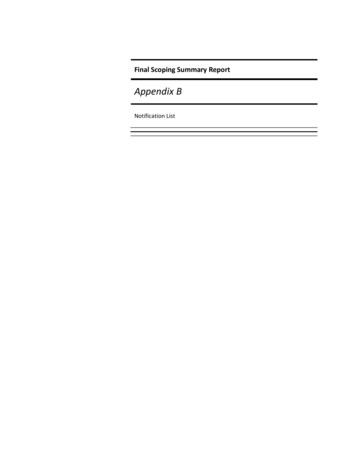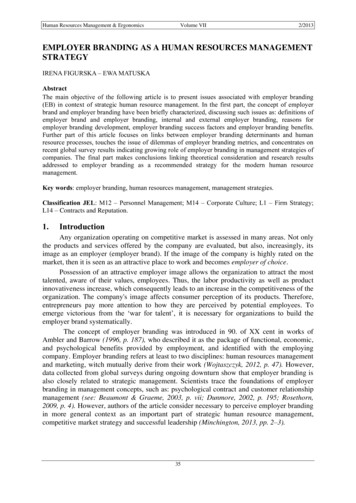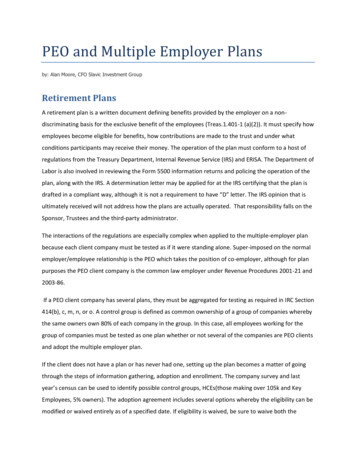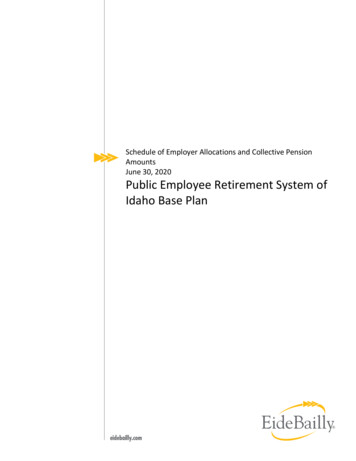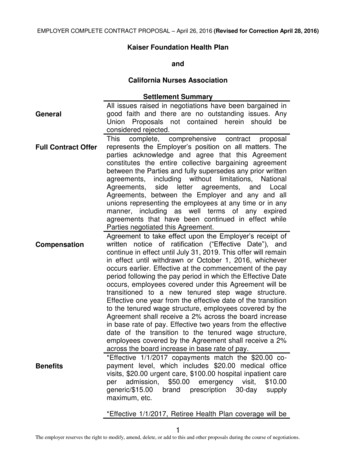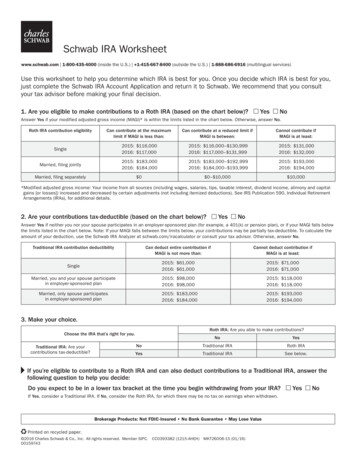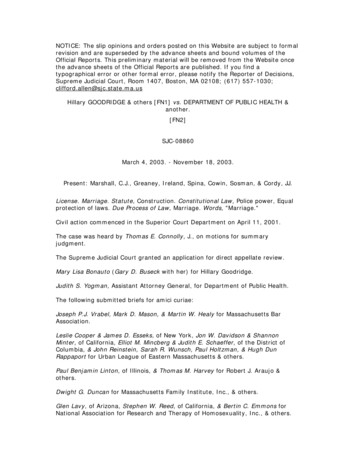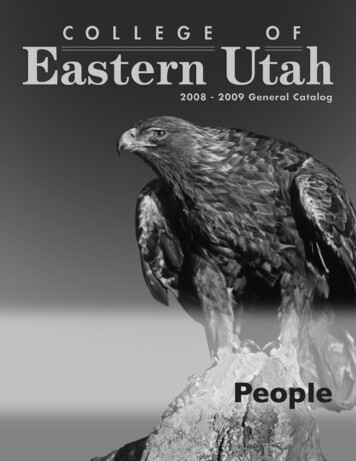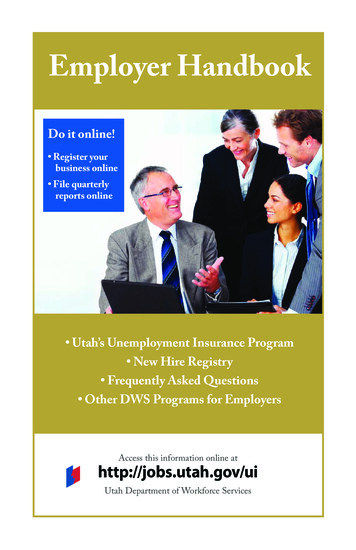
Transcription
Employer HandbookDo it online! Register yourbusiness online File quarterlyreports online Utah’s Unemployment Insurance Program New Hire Registry Frequently Asked Questions Other DWS Programs for EmployersAccess this information online athttp://jobs.utah.gov/uiUtah Department of Workforce Services
ContentsTo Employers. 1About Our Web Site . 1What Is The Purpose of the Utah Employment Security Act? . 2Base Period Wages Defined . 3Who Pays for Unemployment Insurance? . 3Who is Subject to the Employment Security Act? . . 3What Are Wages? . 5What Wages Must Be Reported to Workforce Services? . 7When Are Wages Reportable? . 7What is Employment? . 7Professional Employers’ Organizations and Temporary ServiceEmployers. 8Common Paymaster and Payrolling . 9What Employment is Exempt From Coverage? . 10Guidelines for Employment Status (Independent Contractor). 11What Must an Employer Pay? . 14How is the Contribution Rate Calculated? . 14What is SUTA Dumping?. 17What Does it Mean to Be a “Successor” Employer? . 18Information an Employer Must Provide to Employees . . 19What Records Must An Employer Keep? . . 19Audit of Records . 19What Reports/Forms Must An Employer Submit? . 20Online Filing Options for Utah Employer’s QuarterlyContributions and Wages. 21Equal Opportunity Employer ProgramAuxiliary aids and services are available upon request to individuals withdisabilities by calling (801) 526-9240. Individuals with speech and/or hearingimpairments may call Relay Utah by dialing 711.Spanish Relay Utah: 1-888-346-3162Receive UI Benefits Correspondence Through the Internet. 23When May An Employer Stop Filing Reports? . 25What Are the Penalties When an Employer Does NotFile the Required Reports? . . 25
Can an Employer Receive a Filing Extension? . 26What Should an Employer Know About UnemploymentInsurance Benefits? . 26Some Reasons Benefits May be Denied . 27Unemployment Insurance Claim Center Phone Numbers: . . 28Employer Appeals. 29What Can an Employer Do to Control Unemployment Costs? . 31What is the Purpose of New Hire Reporting and What are theReporting Requirements? . . 33What Can DWS Do For You, the Employer? . . 35Economic Information for Employers . 35Economic Information Products . 36Pre-Layoff Assistance . . 38Conclusion . 38APPENDICESTo EmployersThe information contained in the Employer Handbook is intended to assist you in understanding your rights and responsibilities with respect tothe Utah Employment Security Act (hereafter referred to as the Act) andto the Utah New Hire Reporting. The handbook will also help guide youin preparing required reports.The handbook covers information on Utah unemployment insurance andUtah new hire reporting programs and procedures. In addition, the handbook briefly describes the services the Utah Department of WorkforceServices (DWS) offers employers.This handbook answers the questions that employers most frequently askabout DWS’ programs. If you have a question not covered in this handbook or need additional information, please feel free to contact:Utah Department of Workforce Services140 East 300 South 3rd FloorP.O. Box 45288 Salt Lake City, Utah 84145-0288Email: dws-ui-contrib@utah.govPhone: (801) 526-92351-800-222-2857 if you are calling long distance.Appendix A: Status Report (DWS-UI Form 1). 42About Our Web SiteAppendix B: Employer’s Contribution Report (DWS-UI Form 3). 46Appendix C: Employer’s Quarterly Wage List (DWS-UI Form 3H). 47Our web site at http://jobs.utah.gov.ui contains both public and confidential information and services.Appendix D: Employer Notice of Claim Filed (DWS-UI Form 606). 48The public will find general information on:Appendix E: C.O. Request for Wage Information (DWS-UI Form 625). 49Appendix F: Calculating Excess Wages. 50Appendix G: Utah New Hire Registry Reporting Form (DWS-UI Form 6). 51Appendix H: DWS Employment Center Listing. 52 Tax rates Quarterly reporting Appeals Selected tax forms UI Tax publications, laws and rulesTo access confidential information, you must first create an account usingyour e-mail address and user created password. You are now able to register1
as a new employer or as an employer who has changed the legal status ofyour company. You can also gain access to a specific employer account.statewide system of local employment centers offering employment services, and (3) gathers and dispenses related workforce information.Basic access requires the Utah Employer registration Number and FederalEmployers Identification Number (FEIN). With basic assess, you can:Unemployment insurance benefits are paid to lighten the burden of unemployment for the unemployed individual, maintain employment skills,maintain purchasing power in the community, and allow laid off employees to remain in the area where they will be available for re-employment. File tax reports View or amend tax reportsAny unemployed person may apply for unemployment benefits and, ifeligibility requirements are met, may be paid at a rate determined by theclaimant’s earnings from former employers during the base period. View account profile Make a payment on an accountBASE PERIOD WAGES DEFINED View UI benefit CostsBase period wages used in establishing a claim are the wages paid in the first fourof the last five completed calendar quarters prior to the filing of the claim. Print IRS Form 940CWHO PAYS FOR UNEMPLOYMENT INSURANCE? File New Hire reports View previous new hire reportsAdvanced access requires the Utah Employer registration number andemployer Personal Identification Number (PIN). The PIN is assigned toyou when you register for a Utah employer registration number. With advanced access, you can: Update account addresses Update account contactsThe unemployment insurance program is operated on general insuranceprinciples wherein the employer pays the contributions (taxes) into theUtah Unemployment Compensation Fund (trust fund) to sustain the program. Governmental units, Indian Tribal units, and nonprofit organizations have the option to: (1) pay contributions into the fund based uponpayroll wages in the same manner as other employers, or (2) elect to become reimbursable employers who are liable for direct reimbursement tothe trust fund for benefits paid to individuals formerly in their employ inlieu of paying quarterly contributions.The term nonprofit organization refers only to organizations exempt fromincome tax as described in Section 501(c)(3) of the Internal RevenueCode. These are organizations operated exclusively for religious, charitableor educational purposes. This Department requires a copy of the InternalRevenue Service letter of exemption, 501(c)(3), in order to be recognizedas a nonprofit organization and to elect to become a reimbursable employer. (See item 3 page 4.) Request FEIN changes Close or Reopen account View electronic correspondence Respond to claims filingsWHAT IS THE PURPOSE OF THE UTAH EMPLOYMENTSECURITY ACT?WHO IS SUBJECT TO THE EMPLOYMENT SECURITY ACT?The Utah Employment Security Act: (1) provides unemployment insurance payments to unemployed workers who are eligible, (2) establishes a1. An individual or employing unit that employs one or more individuals2You are subject if you meet any one of the following:for some portion of a day during a calendar year.3
2. You acquired your business from an employer who was subject to thisAct.3. You are a nonprofit organization exempt from income tax as providedby Section 501(c)(3) of the Internal Revenue Code and employ fouror more individuals for some portion of a day in each of 20 differentweeks during a calendar year.WHAT ARE WAGES?Wages in the Act are the same as “currently defined by Title 26, Section3306(b), Internal Revenue Code of 1986.” Additional information can befound in IRS Publication 15, Circular E, Employer Tax Guide and theWeb site for The U.S. Tax Code Online contains a detailed description ofthe definition of wages at:4. You pay cash wages of 1,000 or more in a calendar quarter to a 06.html (casesensitive)5. You employ agricultural workers and pay total wages of 20,000 ormore in a calendar quarter or have more than 10 employees in 20 different weeks during the calendar year.Wages include:er who performs domestic service (household employment).If you are an employer of a domestic service worker or an agriculturalworker or a 501(c)(3) entity and meet the criteria of a subject employer, you are a subject employer for the calendar year regardless ofthe quarter you met the criteria. You also become subject for the nextcalendar year. For example, an agricultural employer who pays wagesin excess of 20,000 in the third quarter of 2009 becomes a subjectemployer effective January 1, 2009. This employer remains subject forall of 2009 and 2010 regardless of the amount of wages paid in theother quarters of 2009 and 2010.6. You are an officer of a corporation receiving remuneration for servicesrendered.7. You are considered to be an employer subject to the Federal Unemployment Tax Act (FUTA). FUTA coverage is based upon the employer’sannual calendar year payroll. If an employer is subject to Utah law byvirtue of being subject to FUTA, all payroll is subject and reportablein all quarters regardless of the payroll amounts.You are an employer according to FUTA if you:a. Paid wages of 1,500 or more in any calendar quarterorb. Employed one or more workers at any time in each of 20 calendarweeks.4 Hourly wages, salaries, and commissions Meals, lodging and other payments in kind Tips and gratuities Remuneration for services of an employee with equipment Vacation pay and sick pay Separation or dismissal pay Bonuses and gifts Payments in stock Employee contributions to Deferred Compensation Plans, including401(k)plansWages do not include:1. Any payment made to, or on behalf of, an employee under a cafeteriaplan. This exclusion is limited to any “qualified (non-taxable) benefit”provided under a cafeteria plan as defined by Section 125 of the Internal Revenue Code. However, employee contributions made under a401(k) plan are wages subject to the Utah Employment Security Actand must be reported.2. Meals and lodging provided on the employer’s premises and for theemployer’s convenience if a good business reason exists for providingthem. Good business reasons include the following:5
a. To have employees available at all times or for emergencies.b. Employees have a short meal period.c. Adequate eating and lodging facilities are not otherwise available.3. Payments made by the employer to a group of individuals in his employ into a fund to provide for:a. Medical or hospitalization expense.b. Death of an employee; provided the employee does not have the rightto any portion of money placed in the fund at termination of the plan,or if the employee terminates employment with this employer.4. Reimbursement and advances for bona fide, ordinary and necessaryemployment related expenses. DWS may require an accounting of theactual expenses or may determine whether the expenses are reasonableand necessary.5. Employment related training allowances (Example: school tuition andfees). However, payments for services performed as part of the training, such as on-the-job training, are wages.6. Remuneration paid to directors of a corporation for director services(i.e., attending board of directors meetings). Director services do notinclude managerial services or other services that are part of the routine activities of a corporation.7. A fee paid to an individual for the referral of a potential customer(finder’s fee) provided that the transaction is in the nature of a single orinfrequent occurrence and does not involve a continuing relationshipwith the person paying the fee.8. Supplemental Unemployment Benefits (SUB) if they meet the requirements specified in Internal Revenue Service Revenue Ruling56-249, 58-128 and 60-330. Because of the complexity of the factorsinvolved, employers should request a declaratory ruling from DWS ontheir specific SUB plans.6WHAT WAGES MUST BE REPORTED TO WORKFORCESERVICES?All gross wages for each individual who worked for you during a calendar quarter must be reported each quarter. However, the Act establishes amaximum taxable wage base that is recalculated annually. No contributionsare assessed on any wages paid to an employee that are in excess of thistaxable wage base. This taxable wage base is recalculated each year based onchanges in the state average annual wage. (See Appendix F.)WHEN ARE WAGES REPORTABLE?Wages must be reported for the calendar quarter in which they are paid,unless you are a domestic employer who has elected annual reporting. The“Due Date” is the last day of the month following the end of the calendarquarter. “Wages paid” are those wages actually received by the worker orconstructively paid without regard to the ending date of the pay period,provided the payment is not delayed beyond customary payment practicesof the employer, contractual agreements between employer and the workers,and state laws. Wages “constructively paid” are wages that should have beenpaid. For example, the pay period for the business is March 15 throughMarch 30. The pay day is the following April 15th. If the wages are not paidto the employee on April 15th, they should have been and hence have beenconstructively paid. These wages need to be reported on the Employer’sQuarterly Contribution Report for the second quarter and can be used bythe employee if he files a claim for unemployment benefits.WHAT IS EMPLOYMENT?“Employment” means all work performed for you by persons (regardless ofage) whom you pay, whether their work is permanent or temporary, parttime or full-time, unless the work is specifically exempted from coverageby the provisions of the Act. Employment includes services performed byofficers of a corporation including “S” corporations.Wages of an individual employed to perform or assist in performing thework of an employee are reportable by you for unemployment insurancepurposes. An individual is deemed to be engaged by the employee’s employer if the employer had actual or constructive knowledge of the workperformed by the individual. This is the case even when the individual ishired or paid by the employee. An employer is deemed to have constructive7
knowledge if he should have reasonably known or expected his employeeto engage another individual.Interstate EmploymentWages are reportable to Utah if:1. The service is performed in this state. Service is considered to beUtah employment if it is performed entirely within Utah. The serviceis also considered to be Utah employment if performed both insideand outside of Utah, but the service outside of Utah is incidental tothe service in Utah.2. The service is not localized in any state. If the service is not localized in any state but some of the service is performed by the employeein Utah, the entire service is covered in Utah if one of the followingconditions apply:a. The employee’s “base of operations” is in Utah (the “base of operations” is the place the employee physically checks in on a regularbasis),b. The employee has no base of operations in Utah but is controlledand directed from basic authority which exists in Utah and theemployee does some work in Utah,c. The employee’s residence is in Utah and a or b above do not apply,ord. If a, b, or c do not apply, the employer may elect the state where theemployee is covered by making the election under provisions forreciprocal coverage (Section 35A-4-106 of the Act).PROFESSIONAL EMPLOYERS’ ORGANIZATIONS ANDTEMPORARY SERVICE EMPLOYERSTemporary service is defined as an arrangement whereby the organization hires it’s own employees and assigns them to a client to support orsupplement the client’s own workforce in special work situations such asemployee absences, temporary skill shortages, seasonal workloads, and special assignments and projects. The assignment of the temporary help musthave a finite ending date and the temporary service employer customarilyreassigns the employees to other client organizations upon the completionof each assignment.A Professional Employer’s Organization is any properly and legally licensedemployee leasing company as defined by Section 31A-40-102 of the UtahCode. A Professional Employer’s Organization enters into a co-employmentagreement with the client which is intended to be an ongoing relationship,rather than a temporary or project specific relationship. In the absence of suchcompliance, DWS may choose to hold the “client employer” as the employing unit. The Utah Administrative Code rules for “common paymaster,” and“payrolling” do not apply to leasing companies who are in compliance withthe Professional Employer Organization Licensing Act.COMMON PAYMASTER AND PAYROLLINGA common paymaster is NOT allowed for unemployment contributionpurposes. A common paymaster situation exists when two or more relatedcorporations concurrently employ the same individual and one of the corporations compensates the individual for the concurrent employment.Payrolling is NOT allowed. Payrolling is defined as the practice of anemploying unit paying wages to the employees of another employer orreporting those wages on its payroll tax reports.Generally an employee is reportable by the employer: Who has the right to hire and fire the employee; Who has the responsibility to control and direct the employee;Professional Employers’ Organizations (also known as employee leasingcompanies) and temporary service employers are employing units thatcontract with the clients or customers to supply workers to perform services. DWS recognizes these types of employing units as defined by theProfessional Employer Organization Licensing Act, Title 31A, Chapter40 of the Utah Code.For unemployment contribution purposes, payrolling is NOT allowed.An exception to this provision is noted in the rules pertaining to Professional Employer Organizations.89 For whom the employee performs the service.
Provided the services are also exempted under the Federal UnemploymentTax Act (FUTA) employment shall not include:9. Pollsters or telephone survey conductors if the individual does not perform the service on the employer’s premises, and the individual is paidfor the service solely on a piece-rate or commission basis.1. Domestic service in a private home, fraternity or sorority if the totalcash remuneration for personal services is less than 1,000 per quarterin each quarter of a calendar year. Unless in the prior year, you paidwages of 1,000 or more in a calendar quarter.10. Casual labor but only if it is not in the course of the employing unit’strade or business.Guidelines for Employment Status (Independentcontractor)2. Agricultural labor as defined by the Act provided that the employerpays less than 20,000 per quarter, in each quarter of a calendar year,for agricultural labor and does not have 10 agricultural employees ineach of 20 weeks during that year. Unless in the prior year, you paidwages of 20,000 or more in a calendar quarter or you had 10 or moreagricultural employees in each of 20 weeks during that year.This contains guidelines for determining status as defined by the Utah Employment Security Act, Section 35A-4-204(3).WHAT EMPLOYMENT IS EXEMPT FROM COVERAGE?Services performed by an individual for wages or under any contract of hire,written or oral, express or implied, are considered to be employment subjectto this section, unless it is shown to the satisfaction of the division that:3. Services performed by an individual owner (proprietor) and the owner’s spouse, parent(s) or minor child (under age 21).a) the individual is customarily engaged in an independently established trade, occupation, profession, or business of the same natureas that involved in the contract of hire for services; and4. Services performed by a general partner. A worker who bears an exempt relationship to all general partners (a minor child in a husbandand wife partnership, for example), would also be exempt.b) the individual has been and will continue to be free from controlor direction over the means of performance of those services, bothunder the individual’s contract of hire and in fact.5. Services performed by a member of a limited liability company (LLC),unless the LLC chooses to report for IRS purposes as a corporationthereby becoming subject to FUTA.The following factors are considered to determine if an individual is customarily engaged in an independently established trade, occupation, profession or business:6. Licensed real estate agents, licensed insurance agents, and licensed security brokers paid on a commission basis. Hourly wages or salariespaid to these individuals are not exempt. Separate Place of Business. The individual worker has his own place ofbusiness separate from that of the employer.7. Salespersons not working on the employer’s business premises who arepaid only by commission and are free from the employer’s control anddirection.8. Private duty registered or practical nurses, if the nursing service is performed in the patient’s home and if substantially all the compensationis from health insurance proceeds. This exemption does not apply ifany of the compensation or fee is paid to a nursing service business.10 Tools and Equipment. The individual worker has a substantial investment in the tools, equipment, or facilities customarily required to perform the services. “Tools of the trade” such as those used by carpenters,mechanics, and other tradespeople do not necessarily demonstrate independence. Other Clients. The individual worker performs services of the same naturefor other customers or clients and is not required to work full time for theemployer.11
Profit or Loss. The worker can realize a profit or risks a loss from expenses and debts incurred through an independently established business activity. Advertising. The worker advertises services in telephone directories,newspapers, magazines, the internet, or by other methods clearly demonstrating an effort to generate business. License. The individual has obtained any required and customary business, trade or professional licenses. Business Records and Tax Forms. The worker files self-employmentand other business tax forms required by the Internal Revenue Serviceand other tax agencies.When an employer retains the right to control and direct the performanceof a service, or actually exercises control and direction over the worker whoperforms the service, not only as to the result to be accomplished by thework but also as to the manner and means by which that result is to beaccomplished, the worker is an employee of the employer for the purposesof the Act.The following factors, if applicable, aid in determining whether an employer has the right to exercise control and direction over the service of aworker. Instructions. A worker who is required to comply with another person’sinstructions about when, where and how he is to work is ordinarily anemployee. This factor is present if the employer for whom the service isperformed has the right to require compliance with instructions. Training. Training a worker by requiring an experienced person to workwith the individual, by corresponding with the individual, by requiringthe individual to attend meetings, or by using other methods, indicatesthat the employer for whom the services are performed expects the services to be performed in a particular method or manner.uling of the services of more than one worker does not indicate controland direction. Work on Employer’s Premises. A requirement that the service be performed on the employer’s premises indicates that the employer for whomthe service is performed has retained a right to supervise and oversee themanner in which the service is performed, especially if the service couldbe performed elsewhere. Personal Service. A requirement that the service must be performedpersonally and may not be assigned to others indicates the right to control or direct the manner in which the work is performed. Continuing Relationship. A continuous service relationship betweenthe worker and the employer indicates that an employer-employee relationship exists. A continuous relationship may exist where work is performed regularly or at frequently recurring although irregular intervals.A continuous relationship does not exist where the worker is contractedto complete specifically identified projects, even though the service relationship may extend over a significant period of time. Set Hours of Work. The establishment of set hours or a specific numberof hours of work by the employer indicates control. Method of Payment. Payment by the hour, week or month points to anemployer-employee relationship, provided that this method of paymentis not just a convenient way of paying progress billings as a part of a fixedprice agreed upon as the cost of a job. Control may also exist when theemployer determines the method of payment.These factors are intended only as guides for determining whether an individual is an employee or independent contractor. The degree of importanceof each factor varies depending on the occupation and the factual contextin which the services are performed. Pace or Sequence. A specific requirement that the service must be provided at a pace or ordered sequence of duties imposed by the employerindicates control and direction. However, mere coordinating and sched-Workers classified as “independent contractors” either by themselves, bythe principal for whom they work, or by contract are not excluded frombeing considered in employment simply because of that classification. TheAct does not contain the term “independent contractor” and an exclusionfor such does not exist. In order for the services performed by workers1213
to be excluded from coverage under the Act, they must satisfy both testsmentioned above.If you have classified or contemplate classifying any of your workers as“self-employed” or “independent contractors,” please notify DWS in orderthat a proper determination of status can be made. By doing this, you mayavoid additional unexpected liabilities, interest and penalties.WHAT MUST AN EMPLOYER PAY?An employer who is subject to the Act is required to pay contributions tothe Utah Unemployment Compensation Fund (trust fund) on a quarterlybasis (annual election for domestic/household employers). These contributions (unemployment taxes) are determined by multiplying the totalsubject wages for all employees each quarter by the employer’s assignedcontribution rate.The entire amount of contribution (tax) must be paid by the employer. TheAct provides penalties for employers who deduct any part of the contribution from the earnings of the employee.Payment should be made by Electronic Funds Transfer (EFT) at https://jobs.utah.gov/ui/Employer/Login.aspx or by check made payable to theUtah Unemployment Compensation Fund (or Utah U.C. Fund).HOW IS THE CONTRIBUTION RATE CALCULATED?New Utah employers are assigned a rate based upon the average rates ofall employers in their respective industries. An “earned” rate based uponpayroll and benefit experience is assigned January 1 of the year followingtheir first full fiscal year ( July 1 through June 30) of reporting.The unemployment insurance contribution “earned” rate for rated or qualified Utah employers is determined from the experience each employer hasaccumulated over previous years of coverage in the Unemployment Insurance Program. Utah’s law calls for a “benefit ratio” to be determined for eachqualifying employer. This means that unemployment insurance benefits paidto your former employees will be used as the primary factor in calculatingyour contribution rate. These payments are known as benefit costs.the total wages of all employers of that individual worker in his base per
book briefly describes the services the Utah Department of Workforce Services (DWS) offers employers. This handbook answers the questions that employers most frequently ask about DWS' programs. If you have a question not covered in this hand-book or need additional information, please feel free to contact: Utah Department of Workforce Services

